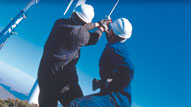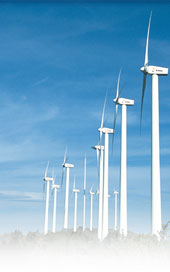3 Rotor structure and materials
For larger wind turbines, the potential power yields scales with the square of the rotor diameter, but the blade mass scales to the third power of rotor diameter (square-cube law). With the gravity load induced by the dead weight of the blades, this increase of blade mass can even prevent successful and economical deployment of very large wind turbines.
In order to meet this challenge and allow for the next generation of larger wind turbines, higher demands are placed on materials and structures. This requires more thorough knowledge of materials and safety factors, as well as further investigation into new materials with a higher strength to mass ratio. Furthermore, a change in the whole concept of structural safety of the blade is required.
The specific objectives of this Work Package are:
• the improvement of both empirical and fundamental
understanding of materials and extension of material
database;
• a study on effective blade details;
• the establishment of tolerant design concepts and
probabilistic strength analysis;
• the establishment of a material testing procedure and design
recommendations.
The R&D activities are subdivided into three tasks:
1: Applied (phenomenological) material
model
The large number of material test results of this task will enable
checking the models derived in task 2 as well as serve as input
data for a number of integration work packages. Together with the
work carried out in task 2, the work of this task will result in an
integrated material model, based on both tests and micro-mechanics,
for which design recommendations and material test recommendations
will be established.
2: Micro-mechanics-based material model
The existing models available in literature will be examined with
respect to damage mechanisms and micromechanics. The
interface/matrix materials influence and fibre fracture/kink-band
formation are considered as most significant mechanisms. They will
be looked upon as part of micromechanics/damage mechanics models,
and results will be incorporated in damage models that can be used
in design processes.
3: Tolerant design concept
This task aims at the development of numerical procedures for
determining strength of a composite laminate, using various failure
criteria to enable the designer to quantify expected blade
reliability. The development of appropriate software in the form of
pre- and post-processors that can be used along with current
aero-elastic codes is foreseen. A blade structural detail will be
selected, analysed and tested also with NDT methods, used in
WP7.
Deliverables
Click here to see the intermediary results of this Work Package.
Leaflet

Rotor structures and materials
Work package leader
• Energy research Centre of the Netherlands -ECN (NL)
Work package partners
• Stichting Kenniscentrum Windturbine Materialen en
Constructies -WMC (NL)
• University of Patras (GR)
• Centre for Renewable Energy Sources -CRES (GR)
• Risø National Laboratory -DTU(DK)
• Vrije Universiteit Brussel -VUB (B)
• Council for the Central Laboratory of the Research Councils
-CCLRC
• Technical Research Centre of Finland VTT (FI)
• Lulea University of Technology (S)
• Fiberblade Eólica S.A. (E)
• GE Wind Energy GmhH (D)
• CENER (E)
Contact details
Mr. Bert Jansen
Energy Centre of the Netherlands (ECN)
P.O. Box 1
1755 ZG Petten
The Netherlands
Tel: +31/224 56 4115
[email protected]

